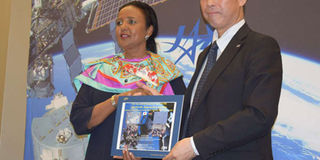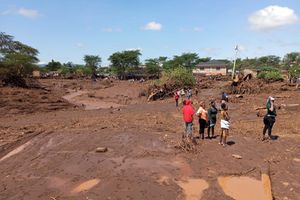How Kenya stands to gain from satellite project

Education Cabinet Secretary Amina Mohamed receives a satellite deployment certificate from Japan Aerospace Exploration Agency President Hiroshi Yamakawa. Kenya successfully deployed its first locally made nano satellite into space. PHOTO | FILE | NATION MEDIA GROUP
What you need to know:
The University of Nairobi defines itself as a collegiate research university.
Progress in modern scientific and technological research requires the ability to compete successfully for research grants.
On May 11, at exactly 1.30 pm Kenya time, the University of Nairobi made history with the deployment of Kenya’s first space satellite. Turkey and Costa Rica also deployed their nano satellites the same day.
But it was not just a historic day for the University of Nairobi. It was historic for all of Kenya. For that was the day when Kenya formally joined the community of nations which have successfully deployed a space satellite developed by their own scientists and engineers.
The venue of this great step into the future was the Tsukuba Space Centre in Tokyo, Japan, in an event witnessed by Education CS Amina Mohamed, who read President Uhuru Kenyatta’s message to those gathered to witness this historic event.
LIVE TRANSMISSION
Also present was the Principal Secretary, University Education, Prof Micheni Ntiba, the Chancellor of the University of Nairobi, Kenya’s Ambassador to Japan and the Vice- Chancellor. And leading the Kenyan technical team was Professor Jackson Mwangi Mbuthia, the current Dean of the School of Engineering, who is also the Principal Investigator of this project.
The Kenyan media also rose to this historic occasion and gave the event saturation coverage, with the NTV providing a live transmission of the satellite launch. In fact all the “big five” media houses gave the event good coverage.
However, for a ground-breaking event like this, after the drama has died down, there is bound to be debate on what the real significance of this occasion was, and how Kenya stands to gain from this project.
This is very much a constant factor in any kind of scientific innovation and investigation.
INNOVATION
In order to answer such concerns, we must refer to the core mission of our university:
The UoN defines itself as a collegiate research university. This means that we place great emphasis on innovation and research. Indeed, we are expected by our mandate to lead the way in all branches of research which fall within our various teaching specialities.
Progress in modern scientific and technological research requires two key components. First, the ability to compete successfully for research grants, through continuing applications for global funding opportunities which come up from time to time. And second, to engage in continual capacity building in cutting edge technologies within the institution, for without such world-class capacity, modern research cannot be successfully conducted.
It is in this context then that – through a highly competitive process – the University of Nairobi was selected to be the first beneficiary of the KiboCUBE programme, supported by the United Nations Office for Outer Space Affairs (UNOOSA) and the Japan Aerospace Exploration Agency (JAXA) which is Japan’s national research and development agency.
CAPACITY BUILDING
The KiboCUBE project was launched in 2015 by UNOOSA and JAXA as a capacity building initiative to offer educational and research institutions from developing countries the opportunity to deploy cube satellites (CubeSats) from Japan’s Kibo Experiment Module of the International Space Station.
Responding to the global announcement of this opportunity, the University of Nairobi, in collaboration with the University of Rome “Sapienza”, worked to develop a CubeSat which was named 1KUNS-PF: the 1st Kenyan University Nano Satellite-Precursor Flight.
The 1KUNS-PF itself is a rather small object, measuring just 10cm x 10cm x 10cm. This is what was launched from the Tsukuba Space Centre.
Its significance lies not in its size (though it is a remarkable example of what can be achieved by Nano technology) but in what lies inside it.
It contains two commercial cameras and experimental web audio upload and broadcast equipment. This allows for earth observation and audio broadcast.
INFORMATION IS POWER
We live in an information age and we can now say that “Information is Power”. Therein lies the significance of our 1KUNS-PF satellite, and indeed the entire KiboCUBE programme.
The Kenyan satellite can provide data services and benefits in such diverse areas as earth mapping; weather forecasting; data collection for applications in agriculture, transport and food security; disaster management; coastline monitoring; land use monitoring; and environmental, livestock and wildlife management.
Prof Mbithi is Vice-Chancellor of the University of Nairobi




